DOH Medicaid Update March 2007 Vol. 22, No. 3
Office of Medicaid Management
DOH Medicaid Update
March 2007 Vol. 22, No. 3
State of New York
Eliot Spitzer, Governor
Medicaid Update
is a monthly publication of the
New York State Department of Health
Office of Health Insurance Programs
Deborah Bachrach, Deputy Commissioner
Table of Contents
National Provider Identification Implementation
Preferred Drug Program News
Medicare Reimbursement
Medicare Part B/D Coverage Flashpoints
Payments to Hospital-Based Clinic Providers when Enrollees are Hospitalized
Family Planning Benefit Program Change in Reimbursement Requirement - Correction
Elimination of Fiscal Order for Plan B - for Women 18 Years of Age and Older Who are Enrolled in the NYS Medicaid Program
New Prior Approval Requirement for Private Duty Nursing Services for Care At Home Waiver Clients
Durable Medical Equipment Provided to Assisted Living Program Participants
Enhancements to Attestation of Resource Coverage Code Editing
Converting to the UB-04 Paper Claim Form
Changes to Paper Claim Forms
Correction in Overpayment of Clinic Claims
Seminar Schedule and Registration
Protect Your Toddler - Prevent Poisoning!
Your Provider Manual is Online
Many of Your Patients May Benefit from the Earned Income Tax Credit
Provider Services
The Medicaid Update is a monthly publication that highlights legal/programmatic changes and important notices pertinent to providers who participate in Medicaid.
The Department of Health is looking at ways to make the Medicaid Update a more useful resource for you. To that end, we would like your opinions about what you'd like to see in this monthly publication.
Your ideas and comments about the content, length, and format of the Medicaid Update will be very useful as we evaluate ways to improve it.
Please take a moment to send your comments by emailing MedicaidUpdate@health.state.ny.us.
Whether it's a few small suggestions or more, we want to hear from you.
Please send your comments back to us by March 22, 2007
Thank you.
ALERT!
National Provider Identifier Implementation
ACT NOW
Return to Table of Contents
As of December 31, 2006, only 6.03 % of New York's Medicaid providers had registered their NPI(s). To be ready for implementation, 100 percent registration is required before the mandated date of May 23, 2007.
If you have not registered your NPI, please visit:
http://www.emedny.org.
To obtain an NPI, please visit:
www.cms.hhs.gov/NationalProvIdentStand.
If you have questions regarding this article, please contact the eMedNY Call Center at: 1-800-343-9000.
Preferred Drug Program News
Return to Table of Contents
Listed on the following pages is the most current Quick List, an easy-to-use summary of the preferred drugs in each PDP category. All drugs on the Quick List are preferred, and do not require prior authorization. Print these sheets and keep them handy.
Prescriber reminder!
- Ambien CR® is preferred on the Preferred Drug List (PDL) and does not require prior authorization. Ambien® is non-preferred and does require prior authorization.
- Both Avelox® and ciprofloacin (tablet, suspension) are preferred on the PDL and do not require prior authorization. Levaquin® is non-preferred and does require prior authorization.
Did you know...
Educational materials have been developed for Medicaid enrollees to help them better understand the Preferred Drug Program (PDP). Brochures are available in English and Spanish. Prescribers and pharmacists may request a supply by contacting First Health Services in Albany at (518) 951-2040.
The full listing of all drugs included on the PDL can be accessed at the following websites or by calling (877) 309-9493:
NYS Medicaid
Preferred Drug Quick List
These drugs are preferred and do not require prior authorization. Return to Table of Contents
| ACE Inhibitors |
|---|
| PREFERRED AGENTS |
| Altace® benazepril captopril enalapril maleate lisinopril Mavik® moexipril |
| ACE Inhibitors + Diuretic |
| PREFERRED AGENTS |
| benazepril/HCTZ captopril/HCTZ enalapril maleate/HCTZ lisinopril/HCTZ Unitretic® |
| Angiotensin Receptor Blockers + Diuretic |
| PREFERRED AGENTS |
| Benicar HCT® Diovan HCT® Hyzaar® Micardis HCT® |
| Anti-Fungals |
| PREFERRED AGENTS |
| Fulvicin U/F® Grifulvin V® (tablet) Gris-PEG® griseofulvin (suspension) Lamisil® |
| Anti-Virals |
| PREFERRED AGENTS |
| acyclovir (tablet, capsule, suspension)® Famvir® Valtrex® |
| Beta Blockers + Diuretic |
| PREFERRED AGENTS |
| atenolol/chlorthalidone bisoprolol fumerate HCTZ metoprolol tartrate/HCTZ propranolol/HCTZ |
| Calcitonins - Nasal |
| PREFERRED AGENTS |
| Miacalcin® |
| Cephalosporins - Third Generation |
| PREFERRED AGENTS |
| Cedax® (capsule, suspension) cefpodoxime proxetil (tablet) Omnicef® (capsule, suspension) Suprax® |
| Hepatitis C Agents |
| PREFERRED AGENTS |
| PEG-Intron® PEG-Intron Redipen® Pegasys® Pegasys Convenience Pack® |
| Immunomodulators (Topical) |
| PREFERRED AGENTS |
| Elidel® Protopic® |
| Inhaled beta2 Adrenergic Agents - Long Acting |
| PREFERRED AGENTS |
| Foradil® Serevent Diskus® |
| Inhaled Corticosteroids |
| PREFERRED AGENTS |
| Advair Diskus® Advair HFA® Asmanex Azmacort® Flovent HFA® Qvar® |
| Narcotics-Long Acting |
| PREFERRED AGENTS |
| Duragesic® fentanyl patch Kadian® morphine sulfate SR Oramorph SR® |
| Proton Pump Inhibitors |
| PREFERRED AGENTS |
| Nexium® Prevacid®(capsule) Prilosec®OTC |
| Serotonin Receptor Agonists (Triptans) |
| PREFERRED AGENTS |
| Imitrex®(tablet, nasal, injection) Maxalt®(tablet, MLT) |
| Thiazolidinediones |
| PREFERRED AGENTS |
| Actos® Actoplus met® Avandia® Avandamet® Avandaryl® |
| ACE Inhibitors + Calcium Channel Blocker |
|---|
| PREFERRED AGENTS |
| Lotrel® Tarka® |
| Angiotensin Receptor Blockers |
| PREFERRED AGENTS |
| Benicar® Cozaar® Diovan® Micardis® |
| Anti-Emetics-Oral |
| PREFERRED AGENTS |
| Kytril®(tablet, solution) Zofran®(tablet, solution, ODT) |
| Antihistamines - Second Generation |
| PREFERRED AGENTS |
| OTC loratadine® OTC loratadine-D |
| Beta Blockers |
| PREFERRED AGENTS |
| acebutolol atenolol betaxolol bisoprolol fumerate labetalol metoprolol tartrate nadolol pindolol propranolol timolol maleate |
| Bisphosphonates-Oral |
| PREFERRED AGENTS |
| Fosamax®(tablet, solution) Fosamax®Plus D |
| Calcium Channel Blockers (DHP) |
| PREFERRED AGENTS |
| Afeditab CR® Dynacirc® Dynacirc CR® felodipine ER isradipine nicardipine HCL Nifediac CC® Nifedical XL® nifedipine Nifedipine ER nifedipine SA Norvasc® Sular® |
| Fluoroquinolones (Oral) |
| PREFERRED AGENTS |
| Avelox® Avelox ABC Pack® ciprofloxacin (tablet, suspension) ofloxacin |
| HMG-CoA Reductase Inhibitors (Statins) |
| PREFERRED AGENTS |
| Advicor® Altoprev® Crestor® Lescol® Lescol XL® Lipitor® Vytorin® Zocor® |
| Inhaled Anticholinergics |
| PREFERRED AGENTS |
| Atrovent® Atrovent HFA® Combivent® ipratropium Spiriva |
| Inhaled beta2 Adrenergic Agents - Short Acting |
| PREFERRED AGENTS |
| albuterol® Maxair Autohaler® Proventil HFA® Ventolin HFA® Xopenex® Xopenex HFA® |
| Leukotriene Modifiers |
| PREFERRED AGENTS |
| Accolate® Singular® |
| Phosphate Binders/Regulators |
| PREFERRED AGENTS |
| Fosrenol® Phoslo® Renagel® |
| Sedative Hypnotics/Sleep Agents |
| PREFERRED AGENTS |
| Ambien CR® chloral hydrate estazolam flurazepam temazepam triazolam |
| Steroids-Intranasal |
| PREFERRED AGENTS |
| Nasacort AQ® Nasonex® |
| Triglyceride Lowering Agents |
| PREFERRED AGENTS |
| gemfibrozil Lofibra® |
Revised 2/1/07
Medicare Reimbursement
Return to Table of Contents
Medicare Part B covers certain drugs such as those used in chemotherapy and with organ transplants; medical supplies, such diabetic and ostomy supplies; and enteral products under certain circumstances.
When a drug, medical supply, or enteral formulae meets the conditions for payment under Part B, the Medicare Part B fiscal intermediary must be billed first.
*Only after Medicare payment information is received may a claim be submitted for Medicaid reimbursement.
Pharmacies have been frequently reminded to enroll in Medicare Part B. Medicaid enrolled pharmacies that are not yet enrolled in Medicare should enroll now.
Information on Medicare enrollment can be found at the following Center for Medicaid and Medicare Services,(CMS), website:
http://www.cms.hhs.gov/MedicareProviderSupEnroll/
____________________________________________
Medicare Part D Program
Medicare Part D is a prescription drug program that provides coverage for most brand name and generic prescription drugs.
Medicare Part B versus Part D Coverage/Billing Issues
A review of claims submitted to Medicaid for full benefit dual eligible enrollees indicate that a number of drugs covered by Medicare Part B have been inappropriately billed to Medicaid instead of to Medicare. To assure the appropriate billing to Part B or Part D, the following tips will help:
- Prescribers can assist in the appropriate billing by including the patient diagnosis, location of administration if not at the patient's home (e.g., prescriber's office, nursing home), and the provider's UPIN (Unique Physician Identification Number) on the prescription.
- Pharmacists can assist by calling the Part D plan with necessary information in order to obtain a prior authorization, exception or billing override for drugs falling into these categories.
- CMS has provided the following chart that provides a quick reference guide for the most frequent Medicare Part B drug and Part D drug coverage determination scenarios.
For more information on Part B versus Part D coverage and billing, go to:
http://www.cms.hhs.gov/PrescriptionDrugCovGenIn/Downloads/PartBandPartDdoc_07.27.05.pdf and
http://www.cms.hhs.gov/Pharmacy/Downloads/partsbdcoverageissues.pdf
Detailed guidance on Medicare Part B/Part D billing was published in the
June 2006 Special Edition Medicaid Update
Medicare Parts B/D Coverage Flashpoints
Return to Table of Contents
This table provides a quick and easy reference guide for the most frequent B/D coverage determination scenarios facing Part D plans and Part D pharmacy providers. It does not address all potential situations.
For more extensive discussion, please refer to the Medicare Part B vs. Part D Coverage Issues document available at: http://www.cms.hhs.gov/PrescriptionDrugCovGenin/downloads/PartBandPartDdoc_07.27.05.pdf
| Part B Coverage Categories | Part B Coverage Description | Retail and Home Infusion Pharmacy Setting B/D Coverage | LTC Pharmacy Setting B/D Coverage | Comments |
|---|---|---|---|---|
| Durable Medical Equipment (DME) Supply Drugs NOTE: Only available for beneficiaries residing in their "home"1 |
Drugs that require administration via covered DME (e.g. inhalation drugs. IV drugs "requiring" 2 a pump for infusion, insulin via infusion pump)3 | Part B | Part D Because most LTC facilities are not considered a beneficiary's "home"4 | Blood Glucose Testing Strips and Lancets covered under Part B DME benefit are never available under Part D because they are not Part D drugs. |
| Drugs furnished "incident to" a physician service | Injectable/intravenous drugs 1) administered "incident to" a physician service and 2) considered by Part B carrier as not usually self administered". | Part D Because by definition a pharmacy cannot provide a drug "incident to" a physician's service (Only a physician office would bill Part B for "incident to" drugs). | Part D Because by definition a pharmacy cannot provide a drug "incident to" a physician's service (Only a physician office would bill Part B for "incident to" drugs). | Part D plans should not implement pharmacy edits to determine B vs. D coverage for injectable/IV drugs only covered under Part B when furnished "incident to" a physician service. |
1 In addition to a hospital, a SNF or a distinct part SNF, the following LTC facilities cannot be considered a home for purposes of receiving the Medicare Part B DME Benefit:
- A nursing home that is dually-certified as both a Medicare SNF and a Medicaid Nursing facility (NF).
- A Medicaid-only NF that primarily furnishes skilled care.
- A non-participating nursing home (i.e. neither Medicare nor Medicaid) that provides primarily skilled care.
- An institution which has a distinct part SNF and which also primarily furnishes skilled care.
2The DMERCs determine whether or not an IV drug requires a pump for infusion.
3The DMERCs do a medical necessity determination with regard to whether a nebulizer or infusion pump is medically necessary for a specific drug/condition.
4If a facility does not meet the criteria in footnote 1, it would be considered a home, and Part B could cover the drugs.
Medicare Parts B/D Coverage Flashpoints
Return to Table of Contents
This table provides a quick and easy reference guide for the most frequent B/D coverage determination scenarios facing Part D plans and Part D pharmacy providers. It does not address all potential situations.
For more extensive discussion, please refer to the Medicare Part B vs. Part D Coverage Issues document available at:
http://www.cms.hhs.gov/PrescriptionDrugCovGenin/downloads/PartBandPartDdoc_07.27.05.pdf
| Part B Coverage Categories | Part B Coverage Description | Retail and Home Infusion Pharmacy Setting B/D Coverage | LTC Pharmacy Setting B/D Coverage | Comments |
|---|---|---|---|---|
| Immunosuppressant Drugs | Drugs used in immunosuppressive therapy for beneficiaries that received a transplant from Medicare approved facility and were entitled to Medicare Part A at the time of transplant (i.e. "Medicare Covered Transplant"). | B or D: Part B for Medicare Covered Transplant Part D for all other situations | B or D: Part B for Medicare Covered Transplant Part D for all other situations | Participating Part B pharmacies must bill the DMERC in their region when these drugs are covered under Part B. |
| Oral Anti-Cancer Drugs | Oral drugs used for cancer treatment that contain same active ingredient (or pro-drug) as injectable dosage forms that would be covered as 1) not usually self administered and 2) provided incident to a physician's service. | B or D: Part B for cancer treatment Part D for all other indications | B or D: Part B for cancer treatment Part D for all other indications | Participating Part B pharmacies must bill the DMERC in their region when these drugs are covered under Part B. |
| Oral Anti-emetic Drugs | Oral anti-emetic drugs used as full therapeutic replacement for IV antiemetic drugs within 48 hours of chemo | B or D: Part B within 48 hrs of chemo Part D for all other situations | B or D: Part B within 48 hrs of chemo Part D for all other situations | Participating Part B pharmacies must bill the DMERC in their region when these drugs are covered under Part B. |
Medicare Parts B/D Coverage Flashpoints
Return to Table of Contents
This table provides a quick and easy reference guide for the most frequent B/D coverage determination scenarios facing Part D plans and Part D pharmacy providers. It does not address all potential situations.
For more extensive discussion, please refer to the Medicare Part B vs. Part D Coverage Issues document available at:
http://www.cms.hhs.gov/PrescriptionDrugCovGenin/downloads/PartBandPartDdoc_07.27.05.pdf
| Part B Coverage Categories | Part B Coverage Description | Retail and Home Infusion Pharmacy Setting B/D Coverage | LTC Pharmacy Setting B/D Coverage | Comments |
|---|---|---|---|---|
| Erythropoietin (EPO) | Treatment of anemia for person with chronic renal failure who is undergoing dialysis | B or D: Part B for treatment of anemia for beneficiaries undergoing dialysis Part D for all other situations | B or D: Part B for treatment of anemia for beneficiaries undergoing dialysis Part D for all other situations | EPO may be covered under Part B "incident to" physician's service for other indications but a pharmacy would not be billing for "incident to" drugs |
| Prophylatic Vaccines | Influenza: Pneumococcal; and Hepatitis B (for intermediate to high risk beneficiaries). | B or D: Part B for Influenza, Pneumococcal, & Hepatitis B (for intermediate to high risk) Part D for all others | B or D: Part B for influenza, pneumococcal & Hepatitis B (for high risk) Part D for all others | Vaccines given directly related to the treatment of an injury or direct exposure to a disease or condition are always covered under Part B |
| Parenteral Nutrition | Prosthetic benefit for individuals with "permanent" dysfunction of the digestive tract. If medical record, including the judgment or the attending physician, indicates that the impairment will be long and indefinite duration, the test of permanence is met. | B or D: Part B if "permanent" dysfunction of digestive tract Part D for all other situations | B or D: Part B if "permanent" dysfunction of digestive tract Part D for all other situations | Part D does not pay for the equipment/supplies and professional services associated with the provision of parenteral nutrition or other Part D covered infusion therapy. |
Reminder!
Payments to Hospital-Based Clinic Providers when Enrollees are Hospitalized
Return to Table of Contents
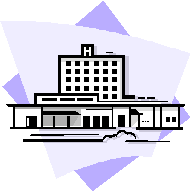
If a Medicaid enrollee receives medical services in a hospital emergency room or hospital outpatient clinic and is subsequently admitted directly to that hospital providing the services on the same day, Medicaid reimbursement is limited to the hospital's inpatient rate.
When an enrollee is admitted as an inpatient from either the hospital emergency room or hospital outpatient clinic, a separate claim for the emergency room or outpatient clinic visit cannot be billed to Medicaid.
Under State Health Department regulations, the Department establishes all-inclusive hospital inpatient rates that generally cover the costs of all medical services provided to Medicaid enrollees during the hospital stay.
No other payment should be made for services provided to these enrollees while they are hospitalized.
Questions? Please contact the Bureau of Policy Development and Agency Relations at
(518) 473-2160.
Attention:
Providers Rendering Family Planning Services to Enrollees Eligible for the Family Planning Benefit Program
CORRECTION
To the February 2007 Medicaid Update Article:
Family Planning Benefit Program
Change in Reimbursement Requirement
Return to Table of Contents
There are corrections to the above titled article, published in the February 2007 Medicaid Update.
The article should have stated that all clinic and practitioner claims submitted on or after May 17, 2007 (instead of "...claims with dates of service on or after....") for Family Planning Benefit Program enrollees must contain a procedure code from the list of family planning procedure codes approved by the Centers for Medicaid and Medicare Services.
The article also should have stated that the primary diagnosis code must be related to family planning and should be in the V25 series (contraceptive management).
Attention:
Physicians and Pharmacy Providers
Elimination of Fiscal Order for Plan B
for Women 18 Years of Age and Older
Who are Enrolled in the New York Medicaid Program
Return to Table of Contents

In August 2006, the U.S. Food and Drug Administration approved Plan B, an emergency contraception drug, as an over-the-counter drug (OTC) for women 18 years of age and older.
For Medicaid payment, OTC drug products require a fiscal order.
However, to assure that there is no delay in treatment, a fiscal order will not be required to support payment for Plan B when provided to women 18 years of age and older.
For women under the age of 18, a prescription will still be required.
Plan B will be limited to 6 courses of therapy in any 12 month period for any prescription and non-prescription combination. This limitation applies to women of all ages.
Pharmacies have been issued billing instructions regarding Plan B claim submission. Pharmacies may have to make adjustments to their own software programs to accommodate this change in Medicaid policy.
If you have any questions, you may contact the Bureau of Policy Development and Agency Relations at
(518) 473-2160.
Do you suspect that an enrollee or a provider has engaged in fraudulent activities?
Return to Table of Contents
Please call:
1-877-87FRAUD
(1-877-877-873-7283)
Your call will remain confidential.
New Prior Approval Requirements
For Private Duty Nursing Services For Care At Home Waiver Clients
Return to Table of Contents
Private duty nursing services provided to children enrolled in certain Medicaid waiver programs, Care At Home (CAH) I, II, III, IV, and VI, will be subject to prior approval review in accordance with the schedule below starting on April 1, 2007.
To facilitate an efficient transition and continuum of care, providers servicing existing cases should submit their prior approval requests to Computer Sciences Corporation (CSC) according to the following time-table:
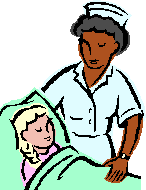
New York City children
April 1 through June 1, 2007
Nassau and Suffolk County children
May 1 through July 1, 2007
Erie, Westchester, Broome, Oneida, Schenectady, Tompkins and Chemung County children
April 1 through August 1, 2007
Rest of State
June 1 through August 1, 2007
Instructions for filling out and submitting the prior approval request form (EMEDNY-361501) can be found in the Private Duty Nursing Provider Manual. The Provider Manual and prior approval request forms can be ordered by calling CSC at 1-800-343-9000. The Provider Manual can also be accessed at http://www.emedny.org/ProviderManuals/NursingServices/index.html
Prior approval reviews for CAH enrollees will be conducted in accordance with standard private duty nursing policy and guidelines as outlined in the Provider Manual. The following documentation is required to be attached to the prior approval requests:
- Physician's order and plan of treatment.
- Certified Home Health Agency assessment or nursing assessment from the local social services district or public health department.
Prior approval requests must list just the procedure codes S9123 for RN and S9124 for LPN without the use of the "-U1" modifier. The "-TT" modifier will continue to be utilized on claims and prior approvals when appropriate to reflect if applicable the individualized care provided to more than one patient in the same setting. Use of the "-U1" modifier on a claim after the transition period will result in claims payment denial.
All cases, regardless of county of residence, not yet authorized to enroll in CAH I, II, III, IV, or VI prior to April 1, 2007 must first complete the eligibility process before pursuing a prior approval for private duty nursing. The CAH eligibility process will proceed as usual via the State Department of Health and Local Social Services Districts or Office of Mental Retardation and Developmental Disabilities (OMRDD) and the Developmental Disabilities Services Offices (DDSO.)
Except as noted in the next paragraph, once the client has enrolled in the waiver and has a Medicaid client identification number, a private duty nursing prior approval request should be faxed to (518) 402- 3253 for preliminary review. Upon receipt of a verbal approval, the prospective provider(s) can begin servicing the case and should submit the completed prior approval request to CSC along with their physician orders to receive the initial prior approval number.
If the client is a resident of Erie, Westchester, Schenectady, Oneida, Broome, Tompkins or Chemung County, requests for private duty nursing prior approval should be submitted to CSC and will be reviewed through that county's prior approval process. Contact numbers for those units can be found on the eMedNY website in the 'Prior Approval Business Location Chart'. All other requests will be reviewed by the DOH Division of Medical Review & Provider Enrollment in Albany. Any request for an increase in private duty nursing hours being provided, must be prior approved by the reviewing office.
Questions related to Care At Home I and II policy and procedures should be directed
to the Bureau of Maternal and Child Health at (518) 486-6562.
Questions related to Care At Home III, IV and VI policy and procedures should be directed to
OMRDD's Care At Home Waiver Unit at (518) 463-6562.
Questions related to PDN billing and ordering and completing prior approval forms should be directed to
CSC at (800) 343-9000.
Questions related to PDN prior approval should be directed to
the DOH Division of Medical Review & Provider Enrollment at (518) 474-3575 or (800) 342-3005.
Durable Medical Equipment
Provided to Assisted Living Program Participants
Return to Table of Contents

The Department of Health and Human Services Office of Inspector General recently conducted an audit of Durable Medical Equipment (DME) Providers Medicaid claims for Assisted Living Program (ALP) participants. Their review identified that some DME providers have inappropriately billed Medicaid for certain DME and supplies provided to ALP participants.
The ALP operates in adult homes and enriched housing programs and provides a combination of residential services and home care services to Medicaid and private pay residents. For each Medicaid enrollee participating in the ALP, a daily rate is paid to the ALP for the provision of nine home care services, including the provision of medical supplies and equipment not requiring prior approval.
ALP payment regulation at Title 18 NYCRR (New York Code of Rules and Regulations) 505.35 (h) states that the Medicaid capitated daily rate is payment in full for the nine covered services.
Department regulation at Title 18 NYCRR 505.5 (d)(1)(iii), governing the provision of DME, additionally states that "Payment will not be made for items provided by a facility or organization when the cost of these items is included in the rate." Consequently, DME providers may only submit claims for a Medicaid eligible ALP participant for DME items requiring prior approval.
Procedure codes that require prior approval are underlined in the DME fee schedule, available at http://www.emedny.org/ProviderManuals/index.html
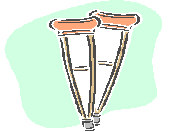
DME providers should work with adult homes and enriched housing programs who operate an ALP and with whom they do business, to establish procedures that will assure appropriate claiming of DME for Medicaid eligible ALP residents.
Questions regarding this article may be directed to the Bureau of Long Term Care at
(518) 474-5271.
MEVS INFORMATION
Enhancements to Attestation of Resource Coverage Code Editing
Return to Table of Contents
The July 2004 edition of the Medicaid Update , introduced Medicaid Eligibility Verification System (MEVS) messages for six new coverage codes. The new codes allow consumers a different scope of Medicaid services based on the disclosure of their financial resources.
- Coverage Code 19 - Community Coverage with Community-Based Long-Term Care.
- Coverage Code 20 and 24 - Community Coverage without Long-Tem Care.
- Coverage Code 21 - Outpatient Coverage with Community-Based Long-Term Care.
- Coverage Code 22 - Outpatient Coverage without Long-Term Care.
- Coverage Code 23 - Outpatient Coverage with No Nursing Facility Services.
A list of services included/excluded under these codes can be found in the July 2004 Medicaid Update.
Effective May 17, 2007, the following changes will be made to the edits associated with certain Coverage Codes.
- Coverage Codes 20 and 24 - Community Coverage Without Long-Term Care and Coverage
Code 22- Outpatient Coverage Without Long-Term Care.
Edit enhancements will permit payment of Certified Home Health Agency (CHHA) services, when the services are associated with Certified Home Health Agencies under categories of service (COS) 0260, 0284 and 0386. For Medicaid consumers with coverage codes 20/24 or 22, up to 29 consecutive days of short-term rehabilitative services in a 12-month period may be covered. - Coverage Codes 10 (All Services Except Long-Term Care ) 19, 20, 24, 21, 22 and 23.
Additional claims will be identified as not payable for waiver services provided under the Long-Term Home Health Care Program, Traumatic Brain Injury Program, Care At Home Waiver Program, the Office of Mental Retardation and Developmental Disabilities Home and Community Based Waiver Program and the Office of Mental Home and Community Based Waiver Program. For Coverage codes 10, 19, 21, and 23 under the Long-Term Home Health Care Program claims for non-waiver services only are payable.
Questions regarding these claim types should be directed to CSC at:
(800) 343-9000.
Attention
Rate Based Providers
Who ARE NOT
Required to Submit Claims Electronically
Converting To The UB-04 Paper Claim Form
Return to Table of Contents
As previously notified in the Medicaid Update, rate-based providers who currently submit the UB-92 paper claim form will need to convert to the UB-04 claim form by May 22, 2007.
Beginning March 1, 2007, Computer Sciences Corporation (CSC) will start accepting the UB-04 claim form.
UB-04 claim forms are not provided by NYS Medicaid and may be obtained from national vendors.
The Provider Manuals section of the eMedNY website now contains Billing Guidelines for the UB-04 claim form for all rate-based providers, excluding Hospital Inpatient, Outpatient and Free-standing Clinic providers who must continue to submit all claims electronically.
To access your provider manual, go to www.emedny.org and click Provider Manuals on the home page. Scroll down to the manual for your specific provider type and click on the appropriate manual. You will see the Billing Guidelines section specific to the UB-04 paper claim form. The UB-92 Billing Guidelines will be kept available on the website until on or around May 22, 2007 as that is the last day CSC will process UB-92 forms.
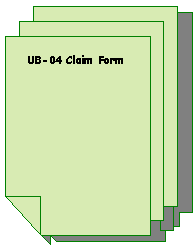
UB 92 forms received by CSC on or after May 23, 2007 will not be processed. Any UB-92 claim form received on or after May 23, 2007 will be returned to the provider.
Specific changes/differences between the current UB-92 claim form and the new UB-04 claim forms were outlined in the January 2007 Medicaid Update.
A recent notice was sent to all providers who use the UB-92 claim form alerting them of a change in procedures due to the lack of a signature box on the new claim form.
Providers who submit only paper claim forms will need to make sure they have an "active" Electronic Transmitter Identification Number (ETIN) on file with CSC before submitting the UB-04 claim form.
If you are a provider who already submits claims electronically, including via ePACES, you already have an active ETIN on file and no further action is necessary.
The ETIN Application and associated Certification Statement required to obtain an ETIN can be found on the eMedNY website. Select Provider Enrollment forms from the Featured Links section of the main page. The forms may take up to two weeks to process and you will be notified in writing of your assigned ETIN. Please note: that the ETIN is not entered on the claim form, but has to be on file with CSC.
Questions about billing on the UB-04 claim form or to verify if you have an active ETIN on file with CSC should be directed to the eMedNY Call Center at
1-800-343-9000.
Reminder
To Providers Who Submit Paper Claim Forms
Changes to Paper Claim Forms
Return to Table of Contents
As you were previously notified in the December 2006 Medicaid Update, beginning March 1, 2007, New York State Medicaid will no longer preprint the following claim forms with your Medicaid Provider Identification Number, and provider name and address.
| Claim Form Type | Provider Types Impacted |
| Claim Form A | Dentists and Transportation |
| Pharmacy Claim Form | Pharmacy |
| NYS HCFA-1500 Claim Form | Chiropractor, Clinical Psychology, Clinical Social Worker, Durable Medical Equipment, Hearing Aid, Laboratory, Midwife, Nurse Practitioner, Physician, Podiatry, Private Duty Nursing and Vision Care |
Note: For group practice claim forms, the Group Provider Identification Number will no longer be preprinted.
Providers should continue to send previously issued preprinted claim forms until their inventories are depleted. Claim forms sent to providers after March 1, 2007 will not be preprinted and will need the following information completed by the provider:
Claim Form A
- Field 1 - Enter the 8-digit Medicaid Provider Identification Number. Below the Identification Number, enter the provider name and address.
- Field 3 - If billing claims with a Group Practice Identification Number, enter the Group Identification Number.
Pharmacy Claim Form
- Field 1 - Enter the 8-digit Medicaid Provider Identification Number. Below the Identification Number, enter the provider name and address.
HCFA-1500 Claim Form
- Field 25A - Enter the 8-digit Medicaid Provider Identification Number.
- Field 25B - If billing claims with a Group Practice Identification Number, enter the Group Identification Number.
- Field 31 - Enter the provider's name and address.
Providers who use a software program to print claim forms will need to make adjustments to their programs to ensure the above information is printed on the forms.
Claim forms that are submitted without the above information will be returned to the provider, unprocessed, if there is a return address on the envelope in which the claim forms were mailed. If there is no return address, the claim forms cannot be returned to the provider and the claim forms will not be processed.
Questions about billing should be directed to the eMedNY Call Center at
1-800-343-9000.
Correction in Overpayment of Clinic Claims
Spanning Multiple Dates of Service
Return to Table of Contents
Effective April 1, 2007, changes have been made to eMedNY claims processing to insure proper payment for follow-up laboratory and radiology services provided to registered clinic patients.
Hospital outpatient departments and diagnostic and treatment centers may only bill one clinic threshold visit per enrollee per day. The clinic threshold visit rate is all-inclusive. When a Medicaid patient receives treatment during a threshold clinic visit which cannot be completed due to administrative or scheduling problems (e.g., follow-up laboratory testing or radiology procedures), Medicaid will not pay for additional clinic visits for completion of the service. These services are part of the initial clinic threshold rate billed to Medicaid.
Some clinic providers may have received overpayments for lab tests and/or radiology follow-up procedures provided to clinic patients. These services were provided subsequent to the date of service for the initial clinic threshold visit, and were incorrectly paid at a full clinic threshold visit rate. Clinics billed a variety of Revenue Codes for the follow-up procedures. These included:
| 030X* - Laboratory |
| 031X - Laboratory Pathological |
| 032X - Radiology - Diagnostic |
| 040X - Other Imaging Services |
| 073X - EDG/ECG |
| 074X - EEG |
| 092X - Other diagnostic |
*Note: 'X' represents a fourth digit within the 0 through 9 range.
To insure proper payment, the Revenue Codes identified above will be paid a rate of $0.00 during clinic line item pricing beginning, April 1, 2007, if the only service reported for the date of service is a completion of service revenue code. Any clinic claim billed with only one or more of the above Revenue Codes will be paid $0.00.
Providers that believe they were paid incorrectly for follow-up clinic care for claims processed on or after March 24, 2005 should submit adjustment claims.
Questions? Please contact the Bureau of Policy Development and Agency Relations at 518-473-2160.

Weekly influenza activity is reported online. Go to:
http://www.health.state.ny.us/diseases/communicable/influenza/surveillance.htm
Seminar Schedule and Registration
Return to Table of Contents
- Do you have billing questions?
- Are you new to Medicaid billing?
- Would you like to learn more about ePACES?

If you answered YES to any of these questions, please consider registering for a Medicaid seminar. Computer Sciences Corporation (CSC) offers various types of seminars to providers and their billing staff. Many of the seminars planned for the upcoming months offer detailed information and instruction about Medicaid's web-based billing and transaction program - ePACES. ePACES seminars are designed for specific provider types.
ePACES is the electronic Provider Assisted Claim Entry System that allows enrolled providers to submit the following type of transactions:
- Claims
- Eligibility Verifications
- Utilization Threshold Service Authorizations
- Claim Status Requests
- Prior Approval Requests
Professional providers such as physicians, nurse practitioners and private duty nurses can even submit claims in "REAL-TIME" via ePACES. Real-time means that the claim is processed within seconds and professional providers can get the status of a real-time claim, including the associated paid amount, without waiting for the remittance advice to be delivered.
Seminar locations and dates are available at the eMedNY website . Seminar registration is fast and easy. Seminars are free to enrolled Medicaid providers.
Go to http://www.emedny.org and select "Training" to find and register for the eMedNY Training Seminar appropriate for your provider category and location. Review the seminar descriptions carefully to identify the seminar appropriate to meet your training needs. Registration confirmation will be instantly sent to your email address.
If you are unable to access the internet to register, you may also request seminar schedule and registration information by contacting CSC's Fax on Demand at 800-370-5809 -- request document number 1000 for a list of seminars and registration information to be faxed to you. Providers who register via fax or regular mail will not receive a confirmation.
Please contact the eMedNY Call Center at (800) 343-9000 if you have questions about registration.
CSC Regional Representatives look forward to meeting with you at upcoming seminars!
Providers
Please copy and distribute to your Medicaid clients.
The Bureau of Injury Prevention asks that you....
Protect Your Toddler - Prevent Poisoning!
Return to Table of Contents
Every 30 seconds a child is poisoned in the United Sates. Poisoning is the third leading cause of injury related hospitalizations for children, ages 1-4, in New York State. Toddlers commonly put things in their mouths as they explore their environment. Many household products can be poisonous if swallowed, come into contact with the skin or eyes, or are inhaled.
The following tips can help you keep a child safe from poisoning.
Store Household Products and Medicines Safely
- Keep all poisons including medicines, cosmetics, household cleaners and chemicals, plants and other substances out of reach of children in locked cabinets or in cabinets secured by safety latches (locks).
- Store all products in their original containers.
- Use child-resistant packaging. But remember - nothing is childproof!
- Have grandparents and caregivers use these safety measures to ensure your child is safe when in other's care.
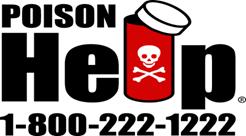
Use Household Products and Medicines Safely
- Lock household products and medicines up immediately after using them.
- Never call medicine "candy" or take it in front of children.
- Dilute old medicines with water, dispose of them down the drain or toilet and rinse the container before discarding. Do not put the container with its contents into the trash.
Teach Children to Ask First
Poisons can look like food or drink. Teach children to ask an adult before eating or drinking anything.
Be Prepared
Post the National Poison Control Hotline phone number (1-800-222-1222) on or near the telephone. Call this phone number right away if you think a poisoning may have occurred.
For More Information
Contact your local Poison Control Center or the New York State Department of Health Bureau of Injury Prevention at (518) 473-1143 or visit these websites:
American Association of Poison Control Centers
http://www.aapcc.org/preventi.htm
National Center for Injury Control and Prevention
http://www.cdc.gov/ncipc/factsheets/poisonprevention.htm
American Academy of Pediatrics http
http://www.aap.org/family/poistipp.htm
Your Provider Manual is Going Online!
Return to Table of Contents
Policy sections of the following manuals are available online at
http://www.emedny.org/ProviderManuals/index.html:
- Assisted Living Program
- Chiropractor
- Clinical Psychology
- Comprehensive Medicaid Case Management
- Dental
- Durable Medical Equipment
- Early Periodic Screening Diagnosis & Treatment for Child Health Plus A
- Hearing Aid
- Home & Community Based Services
- Home Health
- Inpatient
- Laboratory
- Limited License Home Care
- Long Term Home Health Care
- Midwife
- Nurse Practitioner
- Personal Care
- Personal Emergency Response System
- Pharmacy
- Physician
- Prenatal Care Assistance Program
- Private Duty Nursing
- Residential Health Services
- School Supportive Health Services Program
- Transportation
- Traumatic Brain Injury Waiver
- Vision Care
Click on the above link to your manual and you will be brought to your Provider Manual website, where, in addition to policy information, you will find information including billing instructions and fee schedules.
The Provider Manual section of the website is updated frequently with information regarding billing policy and procedure codes/fee schedules.
As a provider, it is your responsibility to check this website on a monthly basis ensure you are current with the latest policy information.
Providers are also responsible for information included in the Information for All Providers Manual, including general Medicaid policy, general billing, inquiry and third party information.
To receive a paper copy of your Provider Manual, you must contact Computer Sciences Corporation at:
(800) 343-900
Providers!
Please Photocopy This Information For Your Patients
Many of Your Patients May Benefit
From the Earned Income Tax Credit!
Return to Table of Contents
The Earned Income Tax Credit (EITC) is an important tax benefit that may be available to your Medicaid and other patients with low earned income. The EITC can significantly increase the available income of low income wage earners.
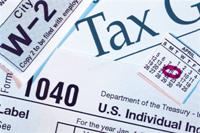
For example, a family with two children and one wage earner holding a full-time minimum wage job can increase their income by over one-third from state and federal EITC(s).
The EITC is not counted as income for Medicaid or Family Health Plus.
Medicaid does not count the EITC as a resource in the month the EITC payment is received or in the following month.
| - Two or more children | $4,536 (federal) + $1,360 (state) = $5,896 |
| - One child | $2,747 (federal) + $ 824 (state) = $3,571 |
| - No children | $ 412 (federal) + $ 123 (state) = $ 535 |

The Volunteer Income Tax Assistance Program (VITA) offers free tax help to people with low earned income. Volunteers are trained to help prepare basic tax returns in communities across the country.
VITA sites are located at community and neighborhood centers, libraries, schools, shopping malls, and other convenient locations. To locate the nearest VITA site, call 800-829-1040.
Please encourage your patients to file a tax return. To claim an EITC credit the wage earner must file a tax return, even if the wage earner's income does not require that a tax return be filed.
Please feel free to copy the following brochure and distribute it to your patients.
Other brochures about this program (available in English, Arabic, Chinese, Russian, and Spanish) along with additional information about the EITC, can be found at:

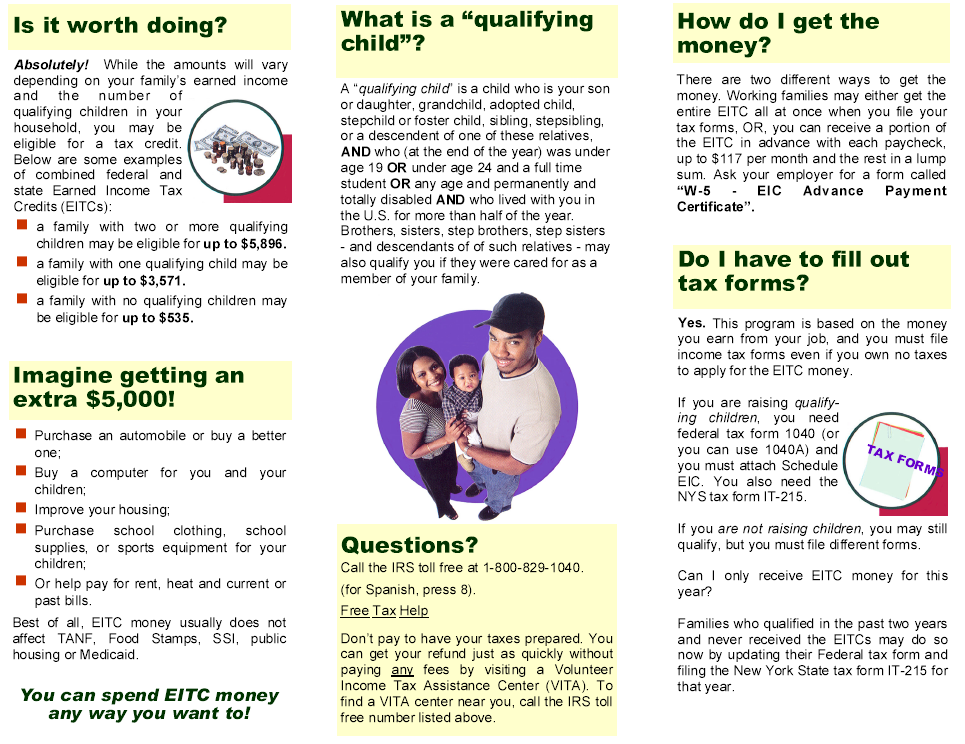
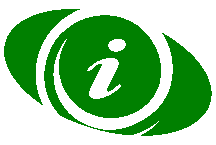
PROVIDER SERVICES
Return to Table of Contents
Missing Issues?
The Medicaid Update, now indexed by subject area, can be accessed online at the New York State Department of Health website:
http://www.nyhealth.gov/medicaid/program/update/main.htm
Hard copies can be obtained upon request by emailing: MedicaidUpdate@health.state.ny.us
Questions About an Article?
For your convenience each article contains a contact number for further information, questions or comments.
Questions about Billing Claims and Performing MEVS Transactions?
Please contact CSC Provider Services at: (800) 343-9000.
Patient Eligibility
Call the Touchtone Telephone Verification System (800) 997-1111, (800) 225-3040 or (800) 394-1234.
Address Change?
Questions should be directed to CSC at (800) 343-9000, option 5.
Fee-for-service Provider Enrollment
A change of address form is available at:
http://www.emedny.org/info/ProviderEnrollment/Provider%20Maintenance%20Forms/6101-Address%20Change%20Form.pdf.
Rate-based/Institutional Provider Enrollment
A change of address form is available at:
http://www.emedny.org/info/ProviderEnrollment/Provider%20Maintenance%20Forms/6106-Rate%20Based%20Change%20of%20Address%20Form.pdf
Comments and Suggestions Regarding This Publication?
Please contact the editor, Timothy Perry-Coon at MedicaidUpdate@health.state.ny.us or via telephone at (518) 474-9219 with your concerns.
The Medicaid Update: Your Window Into The Medicaid Program
The State Department of Health welcomes your comments or suggestions regarding the Medicaid Update.
Please send suggestions to the editor, Timothy Perry-Coon:
NYS Department of Health
Office of Medicaid Management
Bureau of Program Guidance
99 Washington Ave., Suite 720
Albany, NY 12210
(e-mail MedicaidUpdate@health.state.ny.us)
The Medicaid Update, along with past issues of the Medicaid Update, can be accessed online at the New York State Department of Health web site:http://www.health_care/medicaid/program/update/main.htm